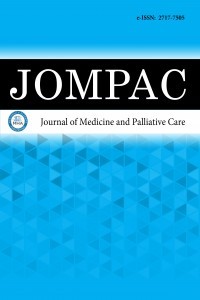Böbrek naklinde de novo uzamış salınımlı takrolimus kullanımı sonuçları: tek merkez, 1 yıllık sonuçlar
Uzamış salınımlı takrolimus, akut rejeksiyon, böbrek nakli
Outcomes of de novo extended-release tacrolimus use (Advagraf®) in kidney transplantation: 1-year, single-center experience
___
- Richter A, Anton SF, Koch P, Dennett SL. The impact of reducing dose frequency on health outcomes. Clin Ther 2003; 25: 2307-35.
- Ingersoll KS, Cohen J. The impact of medication regimen factors on adherence to chronic treatment: a review of the literature. J Behav Med 2008; 31: 213-24.
- Shrestha BM. Two Decades of Tacrolimus in Renal Transplant: Basic Science and Clinical Evidences. Exp Clin Transplant 2017; 15: 1-9.
- Yin J, Hsu T, Kerr JS, Steiner R, Awdishu L. Relationship between 2-Hour Tacrolimus Concentrations and Clinical Outcomes in Long Term Kidney Transplantation. Pharmacy (Basel) 2020; 8: 60.
- Bakr MA, Nagib AM, Donia AF, et al. Comparative analysis for optimizing the modified release tacrolimus (Advagraf) after kidney transplantation: a prospective randomized trial. Saudi J Kidney Dis Transpl 2018; 29: 1267-73.
- Shin TH, Ho MJ, Kim SR, et al. Formulation and in vivo pharmacokinetic evaluation of ethyl cellulose-coated sustained-release multiple-unit system of tacrolimus. Int J Biol Macromol 2018; 109: 544-50.
- Staatz CE, Tett SE. Clinical pharmacokinetics of once-daily tacrolimus in solid-organ transplant patients. Clin Pharmacokinet 2015; 54: 993-1025.
- Wakasugi N, Uchida H, Uno S. Safety and Effectiveness of Once-Daily, Prolonged-Release Tacrolimus in De Novo Kidney Transplant Recipients: 5-year, Multicenter Postmarketing Surveillance in Japan. Transplant Proc 2018; 50: 3296-305.
- Andrés A, Delgado-Arranz M, Morales E, et al. Extended-release tacrolimus therapy in de novo kidney transplant recipients: single-center experience. Transplant Proc 2010; 42: 3034-7.
- Rummo O, Carmellini M, Kamar N, et al. Long-term, prolonged-release tacrolimus-based immunosuppression in de novo kidney transplant recipients: 5-year prospective follow-up of the ADHERE study patients. Transpl Int 2020; 33: 161-73.
- Lee SY, Chu SH, Oh EG, Huh KH. Low adherence to ımmunosuppressants ıs associated with symptom experience among kidney transplant recipients. Transplant Proc 2015; 47: 2707-11.
- Sellarés J, de Freitas DG, Mengel M, et al. Understanding the causes of kidney transplant failure: the dominant role of antibody-mediated rejection and nonadherence. Am J Transplant 2012; 12: 388-99.
- Wiebe C, Gibson IW, Blydt-Hansen TD, et al. Rates and determinants of progression to graft failure in kidney allograft recipients with de novo donor-specific antibody. Am J Transplant 2015; 15: 2921-30.
- Ichimaru N, Kakuta Y, Abe T, et al. Treatment adherence in renal transplant recipients: a questionnaire survey on immunosuppressants. Transplant Proc 2008; 40: 1362-5.
- Saint-Marcoux F, Woillard JB, Monchaud C, et al. How to handle missed or delayed doses of tacrolimus in renal transplant recipients? A pharmacokinetic investigation. Pharmacol Res 2015; 100: 281-7.
- Lehner LJ, Reinke P, Hörstrup JH, et al. Evaluation of adherence and tolerability of prolonged-release tacrolimus (Advagraf™) in kidney transplant patients in Germany: A multicenter, noninterventional study. Clin Transplant 2018;32.
- Bonani M, Balaphas A, Bedino G, et al. Adherence to, and patient convenience of, prolonged-release tacrolimus in stable kidney and liver transplant recipients after conversion from immediate-release tacrolimus in routine clinical practice in Switzerland. Swiss Med Wkly 2021; 151: w20453.
- Tran D, Vallée M, Collette S, et al. Conversion from twice-daily to once-daily extended-release tacrolimus in renal transplant recipients: 2-year results and review of the literature. Exp Clin Transplant 2014; 12: 323-7.
- Cross SA, Perry CM. Tacrolimus once-daily formulation: in the prophylaxis of transplant rejection in renal or liver allograft recipients. Drugs 2007; 67: 1931-43.
- Saengram W, Vadcharavivad S, Poolsup N, Chancharoenthana W. Extended release versus immediate release tacrolimus in kidney transplant recipients: a systematic review and meta-analysis. Eur J Clin Pharmacol 2018; 74: 1249-60.
- Vadcharavivad S, Saengram W, Phupradit A, Poolsup N, Chancharoenthana W. Once-daily versus twice-daily tacrolimus in kidney transplantation: a systematic review and meta-analysis of observational studies. Drugs 2019; 79: 1947-62.
- Crespo M, Mir M, Marin M, et al. De novo kidney transplant recipients need higher doses of Advagraf compared with Prograf to get therapeutic levels. Transplant Proc 2009; 41: 2115-7
- Başlangıç: 2020
- Yayıncı: MediHealth Academy Yayıncılık
Akut böbrek yetmezliğinde hiperüriseminin rolü
Elmas UYSAL, Fatih SEĞMEN, Deniz ERDEM
Primer hipolipoproteinemili hastalarda monosit/yüksek yoğunluklu lipoprotein kolesterol oranı
Yoğun bakım yatışı sırasında radyoterapi endikasyonu konulan hastalarda tedavi sonuçlarımız
Gonca ALTINIŞIK İNAN, İpek Pınar ARAL, Tarık KARGIOĞLU, Çağkan ERGİDEN, Yılmaz TEZCAN
Ezgi EREM, Fatih Mehmet KIŞLAL
Yaşlı hastalarda SGLT2 inhibitörü kullanımı: laboratuvar değerlendirilmesi
Enes Seyda ŞAHİNER, Oğuzhan ZENGİN
Fatih VAROL, Yasar Yusuf CAN, Büşra ÖZGÜNAY, Mehmet CENGİZ, Ugur ALTAS, Şirin GÜVEN, Halit CAM
COVID-19 hastalarında uzamış D-dimer yüksekliği ve herediter trombofili arasındaki ilişki
Kadir Serkan YALÇIN, Hümeyra YÜCETÜRK, Benan KASAPOĞLU, Murat KEKİLLİ
Murat ÖNAL, Mehmet AĞAR, Tuğba GÜRBÜZ
Hashimoto tiroiditinde IL-35 düzeyleri ve tiroid fonksiyon testleri ile ilişkisi
